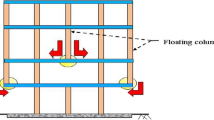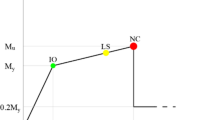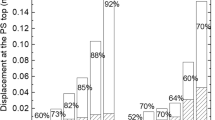Abstract
This study aims to evaluate the seismic performances of bridges isolated by the friction pendulum system (FPS) bearings considering the seismic hazard of Sant’Angelo dei Lombardi site (Italy), to provide useful and preliminary recommendations in terms of health assessment for design or retrofit of new or existing bridges, respectively. Single- and two-degree-of-freedom models are considered to describe the isolated bridge behavior taking into account an infinitely rigid deck and the isolated bridge behavior having an infinitely rigid deck with the elastic pier, respectively. In both models, a velocity-dependent rule for the FPS isolators is assumed. Seismic excitations are properly modeled as non-stationary stochastic processes having different intensities corresponding to different limit states and with frequency contents related to the medium soil condition, representative of the soil type in Sant’Angelo dei Lombardi site (Italy). The statistics of deck and pier responses of the isolated bridge are evaluated for different system parameters such as mass ratio, isolation period, pier period and friction coefficient of the FPS considering both Life Safety and Collapse Prevention limit states according to Italian seismic codes. The results, deriving mainly from the two-degree-of-freedom (2dof) model analyses, show that particular values of the friction coefficient allow to minimize the response of the pier depending on the different system properties and the different limit states. In particular, the optimum friction coefficient of the FPS ranges from 0.01 to 0.04 and from 0.01 to 0.05 for Life Safety and for Collapse Prevention limit state, respectively, depending on the structural properties.














Similar content being viewed by others
References
Clemente P (2017) Seismic isolation: past, present and the importance of SHM for the future. J Civil Struct Health Monit 7(2):217–231
Halabian AM, Zafarani MM, Soheilipour MS, Behbahani S (2016) Optimal semi-active control of seismically excited MR-equipped nonlinear buildings using FLC and multi-objective NSGAII algorithms considering ground excitations. J Civil Struct Health Monit 6(3):561–586
Jangid RS (2004) Seismic response of isolated bridges. J Bridge Eng 9(2):156–166
Tsopelas P, Constantinou MC, Okamoto S, Fujii S, Ozaki D (1996) Experimental study of bridge seismic sliding isolation systems. Eng Struct 18(4):301–310
Ghobarah A, Ali HM (1988) Seismic performance of highway bridges. Eng Struct 10:157–166
Tongaonkar NP, Jangid RS (2003) Seismic response of isolated bridges with soil–structure interaction. Soil Dyn Earthq Eng 23:287–302
Su L, Ahmadi G, Tadjbakhsh IG (1989) Comparative study of base isolation systems. J Eng Mech 115(9):1976–1992
Zayas VA, Low SS, Mahin SA (1990) A simple pendulum technique for achieving seismic isolation. Earthq Spectra 6(2):317–333
Mosqueda G, Whittaker AS, Fenves GL (2004) Characterization and modeling of Friction Pendulum bearings subjected to multiple components of excitation. J Struct Eng 130(3):433–442
Mokha A, Constantinou MC, Reinhorn AM (1990) Teflon bearings in base isolation. I: testing. J Struct Eng 116(2):438–454
Constantinou MC, Mokha A, Reinhorn AM (1990) Teflon bearings in base isolation. II: modeling. J Struct Eng 116(2):455–474
Constantinou MC, Whittaker AS, Kalpakidis Y, Fenz DM, Warn GP (2007) Performance of seismic isolation hardware under service and seismic loading. Technical Report MCEER-07-0012
Almazàn JL, De la Llera JC (2003) Physical model for dynamic analysis of structures with FPS isolators. Earthq Eng Struct Dyn 32(8):1157–1184
Landi L, Grazi G, Diotallevi PP (2016) Comparison of different models for friction pendulum isolators in structures subjected to horizontal and vertical ground motions. Soil Dyn Earthq Eng 81:75–83
Castaldo P, Palazzo B, Della Vecchia P (2015) Seismic reliability of base-isolated structures with friction pendulum bearings. Eng Struct 95:80–93
Castaldo P, Palazzo B, Della Vecchia P (2016) Life-cycle cost and seismic reliability analysis of 3D systems equipped with FPS for different isolation degrees. Eng Struct 125:349–363. doi:10.1016/j.engstruct.2016.06.056
Castaldo P, Amendola G, Palazzo B (2017) Seismic fragility and reliability of structures isolated by friction pendulum devices: seismic reliability-based design (SRBD). Earthq Eng Struct Dyn 46(3):425–446. doi:10.1002/eqe.2798
Palazzo B, Castaldo P, Della Vecchia P (2014) Seismic reliability analysis of base-isolated structures with friction pendulum system. EESMS 2014–2014 IEEE Workshop on Environmental, Energy and Structural Monitoring Systems, pp 114–119
Castaldo P, Palazzo B, Ferrentino T (2017) Seismic reliability-based ductility demand evaluation for inelastic base-isolated structures with friction pendulum devices. Earthq Eng Struct Dyn 46(8):1245–1266. doi:10.1002/eqe.2854
Castaldo P, Tubaldi E (2015) Influence of FPS bearing properties on the seismic performance of base-isolated structures. Earthq Eng Struct Dyn 44(15):2817–2836
Kim YS, Yun CB (2007) Seismic response characteristics of bridges using double concave friction pendulum bearings with tri-linear behaviour. Eng Struct 29:3082–3093
Eröz M, DesRoches R (2008) Bridge seismic response as a function of the friction pendulum system (FPS) modeling assumptions. Eng Struct 30:3204–3212
Castaldo P, Ripani M (2016) Optimal design of friction pendulum system properties for isolated structures considering different soil conditions. Soil Dyn Earthq Eng 90:74–87. doi:10.1016/j.soildyn.2016.08.025
Jangid RS (2005) Optimum friction pendulum system for near-fault motions. Eng Struct 27(3):349–359
Malekzadeh M, Taghikhany T (2012) Multi-stage performance of seismically isolated bridge using triple pendulum bearings. Adv Struct Eng 15(7):1181–1196
NTC08. Norme tecniche per le costruzioni. Gazzetta Ufficiale del 04.02.08, DM 14.01.08, Ministero delle Infrastrutture
Shinozuka M, Deodatis G (1991) Simulation of stochastic processes by spectral representation. Appl Mech Rev 44(4):191–203
Pinto P, Giannini R, Franchin P (2004) Seismic reliability analysis of structures. Iuss Press, Pavia
Kelly JM (1997) Earthquake-resistant design with rubber, 2nd edn. Springer, Berlin
Building Seismic Safety Council (2006) NEHRP recommended provisions: design examples FEMA 451—Washington, DC, August 2006
Priestley MJN, Seible F, Calvi GM (1996) Seismic design and retrofit of bridges. Wiley, New York
Kulkarni JA, Jangid RS (2003) Effects of superstructure flexibility on the response of base-isolated structures. Shock Vib 26:1–13
Pradlwarter HJ, SchuiRler GI, Dorka U (1998) Reliability of MDOF-systems with hysteretic devices. Eng Struct 20(8):685–691
Tung ATY, Wang JN, Kiremidjian A, Kavazanjian E (1992) Statistical parameters of AM and PSD functions for the generation of site-specific strong ground motions. In: Proceedings of the 10th World Conference on Earthquake Engineering, Madrid, Spain, 2:867–872
Kanai K (1957) Semiempirical formula for the seismic characteristics of the ground. Bull Earthq Res Inst 35:309–325
Tajimi H (1960) A statistical method of determining the maximum response of a building structure during an earthquake. In: Proceeding, 2nd World Conference on earthquake Engineering, II:781–798
Clough RW, Penzien J (1993) Dynamics of structures, 2nd edn. McGraw-Hill, New York
Zentner I, Allain F, Humbert N, Caudron M (2014) Generation of spectrum compatible ground motion and its use in regulatory and performance-based seismic analysis. In: Proceedings of the 9th International Conference on Structural Dynamics, EURODYN 2014
Peng Y, Chen J, Li J (2014) Nonlinear response of structures subjected to stochastic excitations via probability density evolution method. Adv Struct Eng 17(6):801–816
Li C, Liu Y (2004) Ground motion dominant frequency effect on the design of multiple tuned mass dampers. J Earthq Eng 8(1):89–105
Lopez-Garcia D, Soong TT (2009) Assessment of the separation necessary to prevent seismic pounding between linear structural systems. Prob Eng Mech 24:210–223
Tubaldi E, Barbato M, Ghazizadeh S (2012) A probabilistic performance-based risk assessment approach for seismic pounding with efficient application to linear systems. Struct Saf 36–37:14–22
Saritaş F, Hasgür Z (2014) Dynamic behavior of an isolated bridge pier under earthquake effects for different soil layers and support conditions. Digest 1733–1756
Talaslidis DG, Manolis GD, Paraskevopoulos EA, Panagiotopoulos CG (2004) Risk analysis of industrial structures with hazardous materials under seismic input. In: 13th World Conference on Earthquake Engineering, August 1–6
Shinozuka M, Sato Y (1967) Simulation of nonstationary random process. J Eng Mech Div 93(1):11–40
Hancock J, Bommer JJ (2006) A state-of-knowledge review of the influence of strong- motion duration on structural damage. Earthq Spectra 22(3):827–845
Hancock J, Bommer JJ (2007) Using spectral matched records to explore the influence of strong-motion duration on inelastic structural response. Soil Dyn Earthq Eng 27:291–299
Barroso LR, Winterstein S (2002) Probabilistic seismic demand analysis of controlled steel moment-resisting frame structures. Earthq Eng Struct Dyn 31(12):2049–2066
Armouti NS (2003) Response of structures to synthetic earthquakes. Emerging technologies in structural engineering. In: Proceedings of the 9th Arab Structural Engineering Conference, Nov 29–Dec 1, Abu Dhabi, UAE, 331–340
Aslani H, Miranda E (2005) Probability-based seismic response analysis. Eng Struct 27(8):1151–1163
Porter KA (2003) An overview of PEER’s performance-based earthquake engineering methodology. In: Proceedings of the 9th International Conference on Application of Statistics and Probability in Civil Engineering (ICASP9), San Francisco, California, 2003
Ryan K, Chopra A (2004) Estimation of seismic demands on isolators based on nonlinear analysis. J Struct Eng 130(3):392–402
Karavasilis T, Seo C (2011) Seismic structural and non-structural performance evaluation of highly damped self-centering and conventional systems. Eng Struct 33(8):2248–2258
Math Works Inc (1997) MATLAB-high performance numeric computation and visualization software. User’s guide. Natick: MA, USA
Jangid RS (2000) Optimum frictional elements in sliding isolation systems. Comput Struct 76(5):651–661
Chung LL, Kao PS, Yang CY, Wu LY, Chen HM (2013) Optimal frictional coefficient of structural isolation system. J Vib Control. doi:10.1177/1077546313487938 (Early view)
Iemura H, Taghikhany T, Jain S (2007) Optimum design of resilient sliding isolation system for seismic protection of equipments. Bull Earthq Eng 5(1):85–103
Fallah N, Zamiri G (2013) Multi-objective optimal design of sliding base isolation using genetic algorithm. Sci Iran A 20(1):87–96
Author information
Authors and Affiliations
Corresponding author
Rights and permissions
About this article
Cite this article
Castaldo, P., Lo Priore, R. Seismic performance assessment of isolated bridges for different limit states. J Civil Struct Health Monit 8, 17–32 (2018). https://doi.org/10.1007/s13349-017-0255-2
Received:
Accepted:
Published:
Issue Date:
DOI: https://doi.org/10.1007/s13349-017-0255-2




